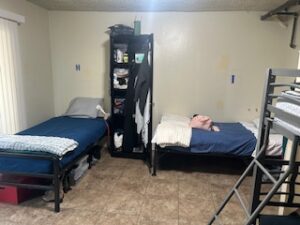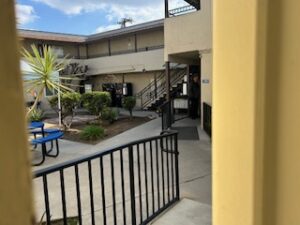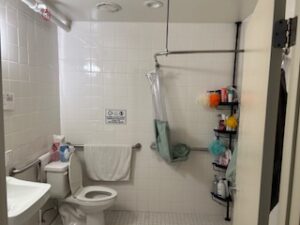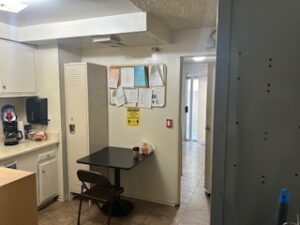The halfway house I’m in is a converted apartment complex with 10 units, housing up to 62 people. Everyone here is a felon, though some residents were placed here instead of returning to prison for a probation violation. Three of the apartments are two-story, while the rest are single-level units on the second floor.




Living Arrangements
Women at this facility share a single apartment. Downstairs, there’s one room with two twin beds and a bunk bed, along with a bathroom that has a handicap-accessible shower. Upstairs, there are two additional rooms, each with three beds, and a shared bathroom. A small kitchenette includes lockers, a sink, a coffee maker, a mini fridge, and a single table with one chair—shared among all female residents.
Men’s apartments follow a similar setup. The two-story units house 10 men each, while the single-level upstairs units accommodate five men per apartment.
The facility features a communal courtyard and an upstairs outdoor TV area, usually tuned to sports or a movie. There’s no WiFi, but personal hotspots are allowed. The office is located in a downstairs unit, along with a laundry room equipped with two sets of washers and dryers.
Meals
One of the downstairs units serves as the kitchen and dining area. Meals are simple:
•Breakfast includes cereal, toast, yogurt, juice, milk, and coffee.
•Lunch is a brown-bag meal with a sandwich, fruit, chips, and a soda.
•Dinner usually consists of a frozen TV dinner, a salad bar, quesadillas, dessert, and either soda or milk.
•Friday nights (every other week) feature fried chicken, pizza, or Panda Express.
•Weekend brunch options include frozen breakfast burritos, breakfast sandwiches, or waffles, along with cereal, toast, and yogurt.
Transportation & Personal Items
Residents are allowed to have a personal vehicle, with parking available both on the street and behind the building. However, the vehicle must be registered, insured, and in the resident’s name—or accompanied by a notarized authorization from the registered owner. Vehicles are subject to random searches.
Cell phones are permitted but are also regularly searched. Video calls, Zoom meetings, and photography on the premises are strictly prohibited. Any communication with inmates—including those residing in the facility—is not allowed.
Residents can bring their personal belongings, including clothing, toiletries, and approved electronics. However, personal pillows are not allowed, though residents may have their own sheets and towels. Food must be stored in a locker or the communal fridge, and leftovers from the kitchen must be consumed within two hours. Microwaves, located in the kitchen, are available only during designated meal hours.
Facility & Daily Routine
The administration building, located within walking distance, is where all required classes are held. These include Introduction to USPO and reentry programs. The facility also has a computer station and payphone-style phones in the courtyard.
Entry to the complex is monitored via a video doorbell system. Food deliveries are allowed during kitchen hours (5:30–7 AM, 11 AM–12:30 PM, and 4–6:30 PM), while Amazon and other package deliveries are permitted at any time. Visitors are allowed on Tuesdays and weekends but must pass a background check.
Employment & Pass System
Residents must secure regular employment—family businesses, 1099 jobs, and commission-only positions are not allowed. Once a formal job offer is received, the job coordinator contacts the employer to inform them that the resident is a felon living in a residential reentry facility. This often results in job offers being rescinded.
However, the facility does have partnerships with local businesses that hire residents for temporary work. Many people work at a cookie factory, a tofu plant, or a call center selling home remodeling services.
As residents continue working, they earn weekend passes, which increase over time:
•Week 1: 2 hours on Saturday and 4 hours on Sunday
•Week 2: 6 hours on Saturday and 8 hours on Sunday
•Week 3: 10 hours on Saturday and 12 hours on Sunday
•Week 4 and beyond: Overnight passes (Friday–Sunday)
Additional passes are available for medical appointments, treatment programs, recreational activities (like going to the park or gym), and shopping. Recreational passes allow for one hour of activity per day, plus up to 40 minutes of travel time. Shopping passes are granted once a week for one hour, with no additional time allotted for travel. Residents may also use social passes to meet friends or family at the park.
Facility Rules & Monitoring
The facility has a 9 PM – 6 AM curfew, with six daily headcounts at 2 AM, 6 AM, 10 AM, 2 PM, 6 PM, and 10 PM. Residents wear lanyards with a name badge and barcode, which are scanned during headcounts.
Smoking is allowed, but vaping is prohibited. Upon returning from any activity outside the facility, residents must take a breathalyzer test. Random urinalysis tests (UAs) are conducted at least once a week.
The director is based at the administration building, and case managers typically defer decisions to the director’s discretion.
Looking Ahead
Overall, the facility isn’t terrible, but I personally see it as a waste of resources—especially for someone like me who has a home and could return within an hour if needed. The system sees it differently, but my time here is almost up.
I’ve already spent seven weeks here and have less than five weeks to go before transitioning to home confinement. At that point, I’ll be monitored even more closely with an ankle monitor from this facility for about five weeks. After that, I’ll be transferred to the Department of Justice, where my probation officer will oversee me for another six months—again with an ankle monitor.
Once that period ends, I’ll begin three years of supervised release, which will resemble my pretrial conditions before sentencing.
This has been a long journey—more than two years so far. I believe that if you don’t learn something from all of this, you’re simply not paying attention.